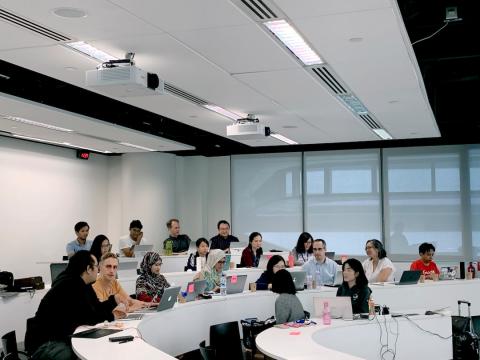From Theory to Practice: A Comprehensive Guide to Implementing Intersectional Frameworks in Your School Curriculum
Apr 20,2023
Are you an educator looking to create an inclusive environment for all students? If so, implementing an intersectional framework is a great way to start.
Intersectional theory was developed in the late-80s by critical feminist scholar Kimberlé Crenshaw. Since then, it has become important when discussing identity and equity in education. However, there's much more to know about classroom equality than improving social studies lessons.
This comprehensive guide will offer a step-by-step guide on how any college or school can begin its journey toward creating change. You'll learn how to create a curriculum grounded in an intersectional approach.
From understanding the fundamentals of intersectionality to taking actionable steps to lead toward lasting change, you'll have everything you need to create an inclusive environment for all.
Current Classroom Demographics
Classroom demographics refer to the characteristics of students from different groups regarding:
- Age
- Gender
- Race
- Ethnicity
- Socioeconomic status
Today's classrooms have become more diverse, including students from different backgrounds and cultures. Students also come from different family structures. Traditional nuclear families are becoming less common.
In the next ten years, fewer White and Black students will be in public elementary and high schools. The number of Hispanic students will continue to grow. Additionally, more Asian and students of two or more races will join the schools. Simply put, demographics are changing, and that shapes education.
Why is this important? Understanding these changing demographics is a key part of intersectionality. They are changes that impact how teachers and schools approach engaging students. Without understanding these demographics, it's hard to create an inclusive learning experience.
Intersectional Framework 101
To navigate these changing times, it’s helpful to focus on intersectionality.
Intersectionality is a way of understanding how different aspects of a person's identity work together to affect their experiences. How does this apply to a school setting? For educators, this means considering how a student's lived experience shapes their life at school.
Why is this so important? Using an intersectional framework helps educators recognize and address each student's unique challenges. By understanding how different identities intersect, schools can create inclusive environments. This can lead to better academic outcomes and a fairer society overall.
How to Promote Equity in the Classroom
Equity in the classroom is an important goal for educators to strive towards. It ensures that all students can succeed regardless of their background or other factors that may impact their learning. Here’s how to create a more inclusive classroom.
Understand Classroom Demographics
Work to recognize and value the diversity of students’ backgrounds, cultures, and experiences. Educators can do this by learning about students’ languages, ethnicities, and religions. They can also do this by creating a curriculum that reflects this diversity.
For example, incorporate literature and media representing different cultures and perspectives. Create activities that promote learning about other cultures. Give students space to talk about their experiences without judgment.
It's also important to create a classroom environment where all students feel:
- Welcomed
- Respected
- Supported
Listen to what each student has to say. Honor their lived experience.
Create an Inclusive Atmosphere
An inclusive environment values students' diverse backgrounds, cultures, and learning abilities. Educators can promote this type of atmosphere by:
- Fostering a sense of community in the classroom
- Encouraging active participation from all students
- Creating opportunities for collaborative learning
- Addressing any harmful behavior or language that could marginalize certain groups of students
Providing diverse learning materials can also help promote inclusivity in the classroom. The focus should always be on providing multicultural perspectives, regardless of the lesson.
Acknowledge All Students
Acknowledging all students involves recognizing and honoring their histories, cultures, and experiences.
Educators can do this by:
- Using students' preferred names and pronouns
- Embedding diverse perspectives and materials in the curriculum
- Encouraging active participation from all students
At the same time, educators must also be aware of their own biases and work to mitigate them.
Deliver High-Quality Education
All students should have access to a high-quality education. This is true regardless of socioeconomic status, race, ethnicity, or gender identity. As an educator, there are several ways to provide high-quality education. Some of these include:
- Using culturally responsive teaching methods
- Creating inclusive classroom environments
- Providing differentiated instruction to meet individual student needs
- Incorporating diverse perspectives and experiences in the curriculum
- Using inclusive language
Regardless, it’s important to stay up-to-date on pedagogical trends. Incorporate classroom technology to make learning easier. Work to offer high-quality teachings and material to every student, regardless of background or ability.
Include Cultural Experiences in the Curriculum
Including cultural experiences in the curriculum is a great way to create an inclusive environment. It's a big part of recognizing and celebrating all students' cultures and experiences. Every student should feel represented. At the very least, they should feel like you're trying to understand who they are.
How can you do this? Incorporate diverse cultures' literature, music, art, and history into lessons. This helps students see themselves and their backgrounds represented in the classroom. You might also invite speakers from various backgrounds to share their experiences. This offers a unique way to introduce new perspectives to the class.
Additionally, it's great to teach students about various cultural festivals and celebrations. It can help students better understand cultural differences and similarities. It’s also a fun way to learn about different lessons outside of using textbooks or computers.
Promote Social Justice
As an educator, you can promote equity by acknowledging and addressing systemic inequalities.
For example, educators could develop lesson plans that explore historical events. Choose to focus on the perspectives of marginalized groups. Or create assignments that require students to engage with diverse literature.
By promoting social justice in the classroom, students will better understand the world around them. They will develop skills for creating a more equitable society.
However, there's one caveat here. In creating these types of classroom lessons, it’s important to understand your privilege. Work to understand how that plays into your role as an educator.
How to Design an Intersectional Curriculum
As you can see, a lot goes into designing an intersectional curriculum. It requires considering all students' unique experiences and backgrounds. The goal? Creating a safe and welcoming learning environment.
We know that this can be tough. So here are some examples of how to design intersectional curricula.
Consider Race and Ethnicity
When designing a curriculum, consider the diverse racial and ethnic backgrounds of students. This means including materials and resources representative of different cultures and ethnicities. It also means being mindful of cultural biases in the curriculum or materials.
Address Immigration and Citizenship Status
This is a tricky subject. It's important to be aware of the immigration and citizenship status of their students. This can impact how they learn and engage with the curriculum. However, you don't want to cross any lines. It's not your right to know their immigration status. It is your responsibility to respect their situation, though.
The goal is to be sensitive to the fact that some students may come from undocumented families. The might also have limited access to resources. In some cases, it could mean there's a language barrier that makes learning difficult.
Ultimately, the important thing is to be mindful of any discussions or activities that may trigger anxiety or fear for these students. If they need help or support, offer them support without judgment.
Account for Economic Backgrounds
It's important to consider students' economic backgrounds when designing a curriculum. This means being mindful that some students may come from families with limited financial resources. Others may be experiencing poverty.
It also means creating opportunities for all students to participate in learning activities. Everybody should have access to classroom resources regardless of their economic circumstances. For example, avoid requiring paid subscriptions to online services or access to computers or WiFi; these aren’t things all families have.
Be Inclusive of Different Abilities
Inclusive curriculum design involves catering to a wide range of abilities and disabilities. This means ensuring that learning activities and resources are accessible to all students.
It also means being mindful of the language used in the curriculum. Certain words or concepts may be triggering or alienating for students with disabilities. Work to be inclusive to all children of every gender or sexual orientation.
Promote Honor Societies
Honor societies are a great way to connect and support various students. They allow students to connect with mentors and the resources they need to succeed.
What might this look like at a school level? Successful diversity and inclusion initiatives through these societies might include:
- Increasing visibility and representation of underrepresented groups in leadership roles
- Hosting events that celebrate classroom diversity
- Implementing policies for inclusive language and behavior
However, sometimes it doesn't even require much work on your end. Simply promoting access to honors societies is often helpful. Letting students know organizations like The Honor Society exists is helpful. Teach them how to navigate and apply for these types of programs.
So, sure, honors societies offer a simple way for educators to create a more inclusive academic community. This is because they can prioritize diversity and inclusion. They’re also a great way to provide students with ways to get ahead in their academic careers.
Helpful Resources
In conclusion, implementing intersectional frameworks into your curriculum is critical. It requires an understanding of all students' diverse backgrounds and experiences. However, by creating a safe and inclusive learning environment, educators can help all students thrive. They deserve this so they can reach their full potential.
If you’re unsure where to start, we urge you to explore all Honor Society resources. We even have a section dedicated to Inclusion & Diversity.





